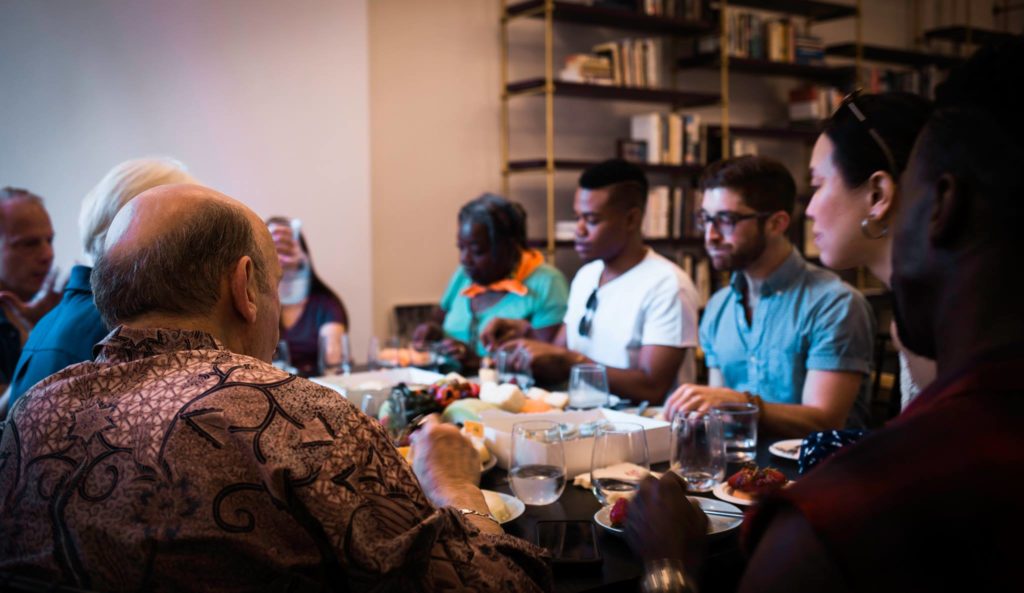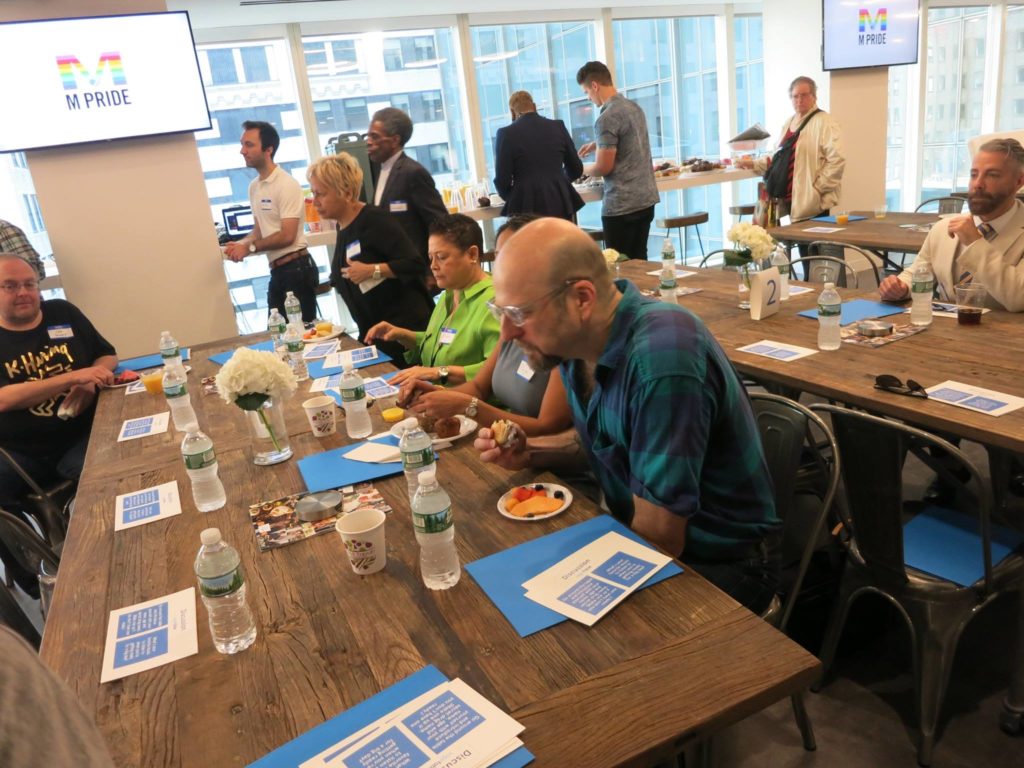On Thursday, May 18th — a scorcher of a day here in New York City — I hopped on my bike and rode across the University Heights bridge from Manhattan to the Bronx to join in on the lunchtime SAGE Table at SAGE’s Bronx Center, one of hundreds of SAGE Table events happening across the country. I arrived, sweaty and hungry, to find the center’s lunchroom decked out in SAGE Table décor and buzzing with excitement. About a dozen attendees were sitting at tables covered in blue and silver cloth, and a table packed with food waited for the clock to strike 11am. I was greeted and welcomed by Marie, a regular SAGE participant, who was designated as the table captain for the 11am event. She asked everyone to sign in and then handed out a series of discussion questions for each participant to consider as we waited for lunch to begin. The questions provided included funny inquiries, such as “What music do you listen to when you’re getting ready to go out?” and “What is your secret drag name?” (do roller derby names count?) along with more serious questions, like “Who do you want to take care of you as you age?”

SAGE Table event in NYC. Photo by Levi Jackman Foster Studio, courtesy of SAGE.
Ultimately, nine people were seated at our SAGE Table: Marie, Dorell, Nora, Joyce, Joe, Celenia, Audrey, Miriam, and me. Most of us lived in Harlem or the Bronx, and several were native New Yorkers. I was the youngest at the table, but there was a good range of ages, from our early 30s to our early 70s. Everyone but me was a regular participant at the SAGE Bronx Center, and they told me about the different activities available in at the center: dances, guest speakers, hair and nail salons, and fitness classes. They shared stories about their lives in New York, how their neighborhoods have changed over the years and what it was like to be in New York during the Stonewall era. Many of them had a harrowing story about living in the closet, when walking down the street holding hands with your same-sex partner meant a certain beating, when parents were unwelcoming and unforgiving of a child’s LGBTQ identity, even long after both parent and child became adults. I was so inspired and humbled by the long lives these elders had lived and the fights they had endured just to be who they are and to love whom they love.
After delicious sandwiches, fruit salad, and pastries, the conversation deepened. Marie said that she was so excited to have someone of a younger generation at the table with them, because she felt that LGBTQ youth didn’t often take the time to connect with their elders. Folks at the table asked questions about identity, language, and how quickly the LGBTQ communities are evolving. There was a lot of interest in learning more about different transgender identities and pronouns, and we had a really great discussion about the meaning of “two-spirit” and how LGBTQ identities are celebrated in indigenous communities in the Americas and Africa. We agreed that SAGE should invite someone to come to the center to talk about transgender identity and answer questions that still lingered after our discussion.

SAGE Table event at M Booth PR in New York. Photo courtesy of SAGE.
As our time ran out and the tables had to be cleared to make way for another SAGE Table lunch event at the center, I asked the group what younger LGBTQ generations could do to support and take (better) care of our elders. Dorell asked that younger generations have compassion for and patience with the older generations who may not always get language or pronouns exactly right on the first try — but whose dedication, struggle, and loss have paved the way for those of us in the younger generations to be as open as we can be with our identities. Many also expressed support for an “Adopt a Senior” program, where younger folks took the time to check in with an older adult to have conversation and make sure they felt cared for and listened to. “We need the young folks to remember that we’re still here,” Marie told me, “and we’re still fighting.”
SAGE Table was a really profound experience for me. My 90 minutes in the Bronx helped me to feel more connected to my community — my physical community here in New York, as well as my LGBTQ community, and the places where the two intersect — and have inspired me to do a better job of connecting with folks of different ages, races, backgrounds, and identities. Even though I work for an organization that advocates for improved aging in diverse communities, the actual elders we serve can feel very far away when I spend most of my time at a computer or on the phone or on the ground in Washington, DC, talking not to older adults but instead to policymakers and advocates who impact their lives. I’m hoping to volunteer at the Bronx center on a regular basis so I can continue to nurture the relationships that began during SAGE Table.
For more information on SAGE Table — and what comes next now that this year’s SAGE Table is over — check out the SAGE website.
The opinions expressed in this article are those of the author and do not necessarily reflect those of the Diverse Elders Coalition.

